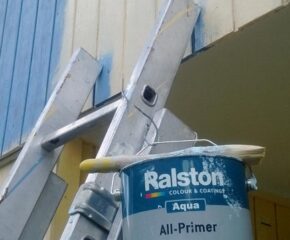When you start painting, you naturally want to ensure that the surface is not damaged. The choice of the right masking tape is crucial here. In this blog we will discuss which type of adhesive tape is best to use for different surfaces and give you tips to prevent damage. Whether you are working on rough surfaces, delicate surfaces or damp surfaces, the right tape will ensure clean lines and prevent paint from seeping underneath the tape. And by using high-quality masking tape, you can also be sure that no glue residue will be left behind.
What is the difference between paper tape, masking tape and painter’s tape?
Although paper tape, masking tape and painter’s tape are often used interchangeably, they have subtle differences.
Paper tape is often used as a general term for tape used to cover surfaces during painting. It can vary in adhesive strength and width depending on the application. You can get suitable paper tape for every paint job.
Masking tape specifically refers to tape that can withstand high temperatures, making it ideal for industrial applications such as automotive refinishing or covering surfaces during soldering. It leaves no adhesive residue and provides for a clean edge.
Painter’s tape is a type of paper tape specially developed for painting. It ensures sharp paint lines and prevents the bleeding of paint. It adheres well to various surfaces and is easy to remove without damaging the paint.
In short, while all these tapes serve to protect surfaces and create sharp lines, they each have their own specific properties and applications.
Tips for using paper tape
- Clean the surface:
Make sure the surface is clean and dry before you apply the tape. This ensures strong adhesion and prevents the tape from coming loose. When working on damp surfaces, choosing the right tape is extra important. - Use the right type of tape for the right type of surface:
Choose a tape that is suitable for the type of surface you are going to paint. There are different types of tapes for different applications, such as crepe masking tape for painted surfaces, gold-yellow masking tape for paint jobs with clean paint lines and purple paper tape for sensitive surfaces, such as wallpaper and freshly painted surfaces. - Work carefully:
Masking is not difficult. Anyone can apply some tape! Work carefully and take your time to mask off properly. Press the tape down firmly. This helps create clean paint lines and prevents paint from creeping underneath the tape. Want to make sure no paint gets underneath the masking tape? In that case, opt for Frogtape painter’s tape, for example. - Removing painter’s tape:
Remove the tape once the paint is dry to the touch, but not fully cured. This will prevent the paint from peeling or cracking while you remove the tape. A quality masking tape has good adhesive strength, while easy to remove without leaving any adhesive residue.
What kind of paper tape do painters use?
Professional painters often choose blue paper tape or yellow paper tape because of its versatility and strong adhesion. Brands often used by a painter are tapes from Tesa or Kip. These products are suitable for windows, doors, skirting boards, walls and other surfaces. You can get suitable painter’s tape for every type of surface.
Blue paper tape is used both indoors and outdoors and can be used on various surfaces without leaving adhesive residue, while yellow paper tape creates sharp lines. In addition, purple paper tape is a popular choice for fragile and sensitive surfaces. It allows you to mask without causing damage to, for example, wallpaper and freshly painted surfaces.
To prevent paint splashes, you can use plaster runner, masking paper or cover foil. To tape down plaster runners on floors, you can use crepe (beige) tape, but we often also see painters opt for wide adhesive tape or duct tape for this. The beige or yellow painter’s tape does the job of taping down covering plastic on furniture, etc.
Does paper tape leave adhesive residue on my walls?
Properly applied, high-quality tape will not leave any adhesive residue on your walls, provided you remove the tape correctly. Once the paint is dry, slowly pull the tape away at a 45-degree angle. Choose quality masking tape and avoid cheap variants that are more likely to leave a residue. Painting without causing issues later on starts by using the right tape, which ensures a smooth and professional result.
Is there a difference in quality between cheap and more expensive painter’s tape?
Cheap painter’s tape may seem attractive, but often this tape comes loose quickly, tears too easily and/or causes ragged paint lines. More expensive painter’s tape, on the other hand, offers better adhesion and clean lines, without leaving any adhesive residue.
Invest in quality tape for professional results and less frustration. The right painter’s tape saves time and ensures a perfectly finished project, allowing you to be proud of your work.
Removing painter’s tape; useful tips & tricks
Removing paper tape can be challenging if not done properly. Here are some tips to make it easier:
– Wait for the paint to dry, but remove the tape before the paint has completely cured.
– Then, slowly pull the tape away from the painted line, at a 45-degree angle. This prevents the paint layer from cracking.
– If the painter’s tape does not come off easily, use a sharp knife to carefully cut the edge of the tape. This way the paint remains undamaged and your paint job gets the best result.
The best paper tape for different surfaces
Vulnerable surfaces such as freshly painted walls
For delicate surfaces such as wallpaper or freshly painted walls, you need masking tape that is not too sticky. The purple paper tape is ideal for this job. This painter’s tape provides a soft adhesive bond and is specially designed to minimise damage.
Rough surfaces
For uneven and rough surfaces such as brick or concrete, blue paper tape would be a good choice. This paper tape is stronger, has good adhesive strength and adheres well to rough surfaces.
Smooth surfaces
On smooth surfaces such as smooth plasterwork, windows, doors or skirting boards, you want a painter’s tape that guarantees strong adhesion with extra clean lines, such as gold-yellow paper tape. This tape leaves no adhesive residue, is easy to remove and produces a neat result.
Neat painting with the right tape
Painter’s tape, paper tape or masking tape is available in different colours and different widths. They are all designed to finish your paint job with clean paint edges. By choosing the right paper tape, applying it correctly and not leaving it on for too long, you can rest assured that your painting project will be a success without damaging the surface. Whether you want to create a straight line or mask off specific areas, there is always an ideal painter’s tape to suit your job. Turn your painting project into a professional job with clean lines and the right paper tape.



